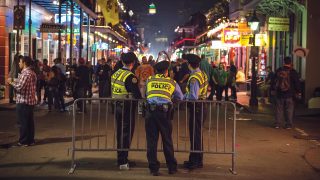
When analyzing evidence or investigating a crime scene, an eye for detail is vitally important for law enforcement. Officers with the NYPD and several federal agencies are honing that eye for detail in an unexpected place — an art class.
Art historian Amy Herman teaches a class called “The Art of Perception,” which uses
When analyzing evidence or investigating a crime scene, an eye for detail is vitally important for law enforcement. Officers with the NYPD and several federal agencies are honing that eye for detail in an unexpected place — an art class.
Art historian Amy Herman teaches a class called “The Art of Perception,” which uses fine art to strengthen individual powers of observation and challenge inherent bias. Herman, who is a former lawyer, repeatedly saw the effect of dulled perception in the courtroom. Eyewitness testimony frequently was either not detailed enough or outright wrong, with the eyewitnesses unaware that it was because of their own lack of perception.
With that in mind, Herman developed “The Art of Perception” in 2001, when she was working in the education department at New York City’s Frick Collection. Famous works like Hieronymus Bosch’s Garden of Earthly Delights are used as lessons in objectivity — explain what’s there without emotion. Édouard Manet’s A Bar at the Folies-Bergère is an exercise in standing in someone else’s shoes — look through the bartender’s eyes. What does she see?
The initial target group for the class was medical students, whose split-second judgments and observations could mean life or death. However, medical students proved to be rather single-minded. When they analyzed art, they looked at it solely from a medical perspective.
“They kept saying, ‘Who has cancer? Who has an illness?’” Herman told CNN. “Medical students don’t have much peripheral vision.”
Herman realized her class needed to be targeted to another group, so she cold-called the NYPD in 2004. Little did she know how important that phone call would be. The NYPD was receptive to the class, and it has grown exponentially from there — Herman has now taught the course more than 1,000 times, and her clients include the Chicago P.D., Special Operations Forces, the Department of Defense and the FBI.
In addition to honing individuals’ eye for detail, Herman’s class also focuses on fighting internal assumptions when communicating with others. In fact, the Chicago P.D. uses an image from Herman’s book, Visual Intelligence, in its bias training. The image shows a white English policeman running behind a black man in plain clothes. Most people assume the black man is running from the policeman, but he is actually a detective wearing everyday clothes.
“We put that right to use,” Commander Daniel Godsel, a 28-year veteran with the Chicago P.D., told CNN.
Godsel reached out to Herman after reading Visual Intelligence and realizing how important its lessons could be to officers. He was uniquely drawn to her methods due to his fine art education from the School of the Art Institute in Chicago.
“As I rose through the ranks, people would ask me, ‘Did the art background and training have an effect?’” he said. “There is something to that. By training in the art field, your brain tends to adapt and see things in a way people might not see.”
Cops must always be on the lookout for the tiniest details that can help them solve a case, and they must constantly be mindful not to make assumptions.
Godsel said that analyzing art concepts can build on the awareness training and discipline that officers are taught in the police academy. Once he reached the end of Herman’s book, he considered it a must-read for all cops.
Cops must always be on the lookout for the tiniest details that can help them solve a case, and they must constantly be mindful not to make assumptions. Godsel illustrated that point with an example from earlier in his career, when he and his partner were called on a standard wellness check.
It was a cold winter day in Chicago, and they arrived to find a young teenage girl wearing socks and no jacket. She wouldn’t say much to the officers and was quickly joined by a young, clean-cut man, who said he was watching his girlfriend’s little sister. Their stories matched — he knew the girl’s name and age, her sister’s name, where her sister worked, phone numbers and other details. But something still seemed off.
“The answers were coming too quickly and too casually,” Godsel said.
Plus, where was her jacket? Why was she only in socks? Knowing that female victims are occasionally not comfortable speaking with male officers, Godsel asked a female officer to come to the bungalow. As it turned out, the girl had been abducted off the street. The perpetrator had first driven around with her to learn as much personal information as possible before sexually assaulting her.
Godsel said that noticing the girl’s missing jacket represents an important point in Herman’s course: What isn’t there is just as important as what is.
That kind of attention to detail is demonstrated in another case that Herman uses in her course. She tells the story of a New York City detective who was called to a crime scene where he was told a female prostitute had been killed.
When he arrived, he noticed a small detail that didn’t seem to fit — the victim had matching well-manicured fingernails and toenails. That wasn’t something he’d seen often in local sex workers, and he thought the polished nails hinted that this Jane Doe was somebody else. And he was right. The woman was actually a missing criminal justice grad student.
The detective’s eye for detail led him to the truth, and he told Herman that it was her class that taught him the skills he needed to notice what felt wrong.
“When he got to the crime scene, he said, ‘I remembered from your class: Look at the big picture, and look at the small details,’” Herman said.
That ability to stop and look for the tiniest details doesn’t come naturally to most people. According to the Visual Intelligence blog, the museumgoer only looks at a painting for 17 seconds. That isn’t nearly long enough to actually notice and appreciate the details of what you’re looking at, and that lesson is at the heart of what “The Art of Perception” teaches. It makes officers realize how much they aren’t seeing as well as how much they are capable of seeing if they take their time and make the effort.
“In this disengaged world that we’re living in, art from the 12th, 13th and 14th centuries still has the power to engage people to look more carefully,” Herman said.
So next time you want to hone your investigative eye for detail, try taking a trip to your local art gallery and pay close attention.
As seen in the April 2020 issue of American Police Beat magazine.
Don’t miss out on another issue today! Click below:





